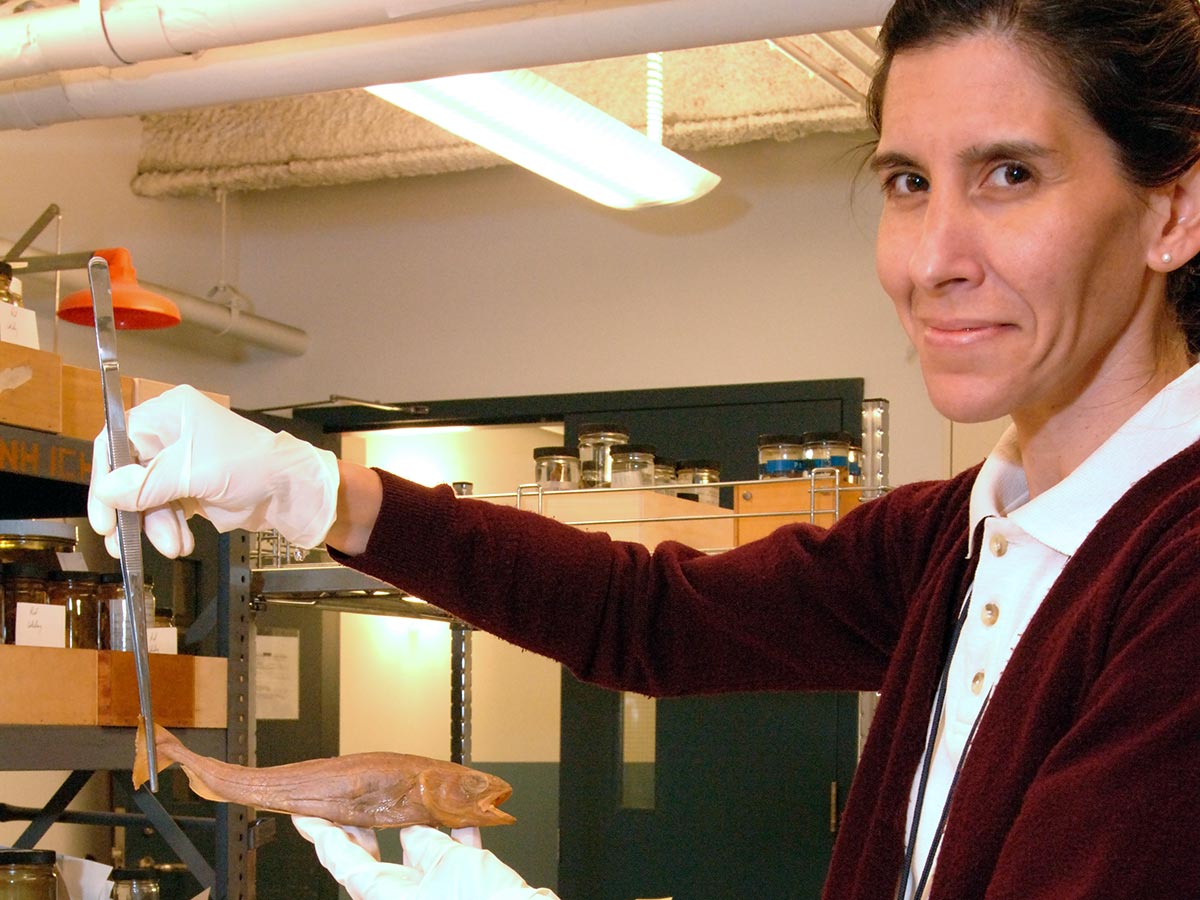COURSE AUTHOR
Adriana Aquino

Dr. Adriana Aquino is Science Content Specialist in the Department of Education at the American Museum of Natural History. As such, her main task is to develop scientific content for professional development programs and publications for educators, consultations, conferences, exhibits, and K-12 students. She also teaches graduate courses for educators through partnerships between the Museum and the City University of New York (Brooklyn and Lehman Colleges), Columbia University Teacher’s College, and the Bank Street School of Education. Course topics range from teaching about the different kinds of fish to how to teach science in informal settings such as museums and the nature of science. Adriana is also a Research Associate in the Museum’s Department of Ichthyology.
Adriana’s scientific work has focused on the systematics of armored catfishes. Systematics is the biological discipline that focuses on the discovery, description, and classification of species. Her favorite part is using bones, nerves and other characteristics to reconstruct evolutionary relationships among fish species. Their classification is based on the ‘family trees’ that she reconstructs from these clues to the past.
Born in Buenos Aires, Adriana moved with her family to Tucumán, in northern Argentina, when she was six. Although Tucumán is a landlocked city, the oceans became her passion. In middle school, after learning about plate tectonics and how the ocean floor forms at the mid-Atlantic ridge, she decided to become a marine scientist.
After high school, she applied to get a Licenciatura in Zoology. Studying systematics and evolution was a transforming experience. Looking through her microscope became a journey back in time, and Adriana was captivated by this window into the complexity of nature. Eager to do research, she started working with two plankton specialists. The two professors were investigating the biological status of a reservoir in Tucuman, and needed to find out whether Oligosarcus, a very common fish in the reservoir, ate plankton. Choosing that as the topic for her Licenciatura thesis, she joined the team.
Adriana had to decide how and what to sample, what questions to ask, and which variables to consider. Over a two-year period she traveled to the reservoir every two months to collect specimens and data. She’ll never forget sitting in a little boat under the stars on frozen nights. Back in the lab, she processed the results of her fieldwork, analyzing hundreds of fish stomachs and running a statistical analysis on her data. Adriana learned that these fishes ate anything available to them: insects, plants, plankton, and other fishes (sensible behavior in a reservoir’s ever-changing environment). She defended her thesis and was awarded the degree in 1989.
Though Adriana was finally studying fish, their classification intererested her more than their ecology. In 1988 she’d taken an ichthyology course at the University of La Plata, a city close to Buenos Aires. Hooked, in 1991 Adriana moved to La Plata and enrolled in their PhD program. She did her thesis on the systematics of a group of armored catfishes widely distributed across tropical South America, whose bodies are covered by bony plates. One of the largest families of freshwater fish in the world, the family Loricariidae includes around 1,000 species. In La Plata Adriana honed her scientific skills, learned how to work in a team, and enjoyed field trips to different regions of Argentina, getting wet now and then.
Adriana was awarded her Doctorate in Natural Sciences in 1994 and spent the next three years a Postdoctoral researcher and teaching assistant in the same department. Her main goal was to keep studying armored catfish, so she asked Dr. Scott Schaefer, a specialist in catfishes at the Academy of Natural Sciences in Philadelphia, to be her advisor in her application for a Postdoctoral Research Fellowship. Dr. Schaefer responded enthusiastically but informed her that he had just accepted a curatorial position at the American Museum of Natural History in New York. To her delight, she was accepted for a one-year postdoctoral position that started in November 1997. Her project, "The Systematics of Hypoptopoma," extended her research on the same group of catfishes. It involved contacting people and institutions across the United States, Europe, and South America, in order to borrow from their collections. A highlight of those years was a 1998 trip to Manaus, Brazil, the capital of the Amazonas State. Looking out of the plane down at that immense expanse of rivers and jungle, she silently promised to continue to work on biodiversity projects, no matter what it took.
After three years as a Postdoctoral researcher in the Museum's Department of Ichthyology, Adriana was hired as science content specialist in the Department of Education. Her goal is to enhance the connection between scientists and science teachers, a task she greatly enjoys. Through activities that range from chatting with kindergarten classes to teaching graduate students the philosophy of science or teachers about the challenge of science communication, Adriana is committed to helping people appreciate nature through science.